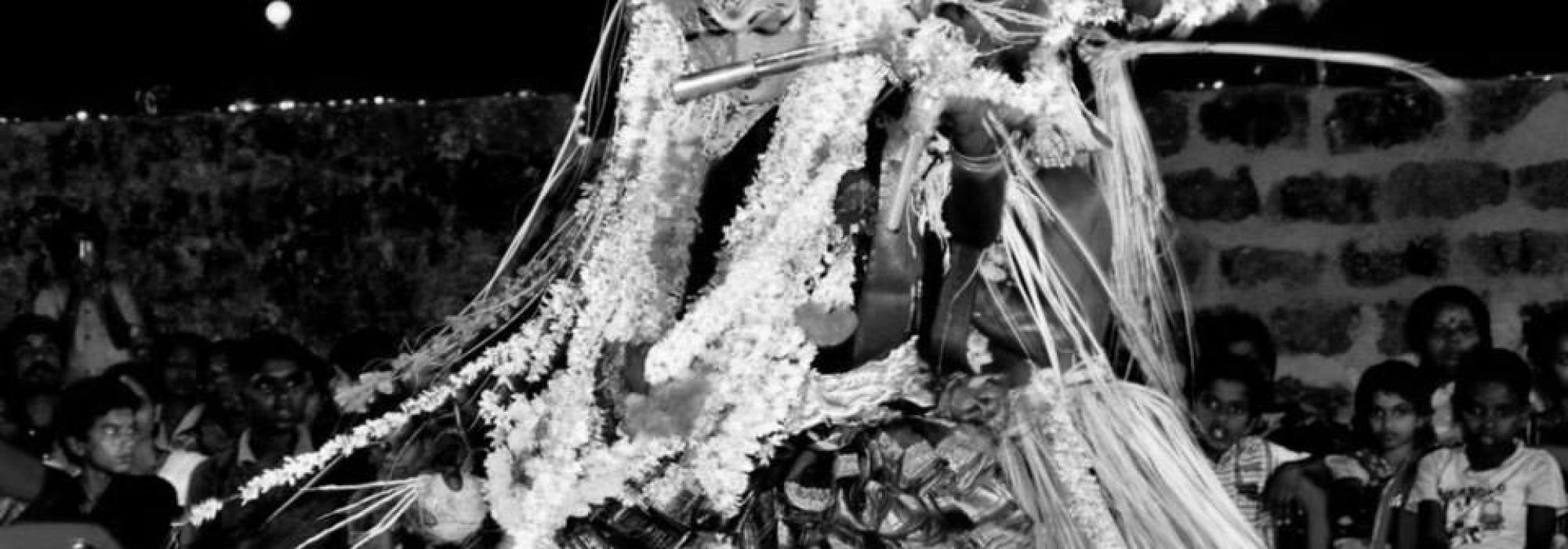Several people have the tendency to find parallels between Bhūtārādhana and Yakṣagāna. They classify Bhūtārādhana as ‘folk’ (Jānapadīya) and as a corollary, conclude that Yakṣagāna is ‘folk’ as well. However, Yakṣagāna’s allied forms of art such as Terukkūttu, Kūcupuḍi, Bhāgavatameḻa, Dūḍālapāya, Doḍḍāṭa and Keḻike are not influenced by Bhūtārādhana at all. Among these, one can say that only Kathakali has faint reflections of Bhūtakola in it. When this is the case, how can the argument that Yakṣagāna is also ‘folk’ be substantiated? Moreover, a complete theatrical form such as ‘Kūḍiyāṭṭam’, which is said to be purely ‘Śāstric’ and ‘Mārga’ (Classical) has borrowed the aspects of āhārya (costumes, props) from Bhūtārādhana. Why not classify Kūḍiyāṭṭam as ‘folk’ too? If we are to say that all ritualistic worship (‘ārādhana’) have their roots in the folk tradition – in reality, several of them are forms of dance – why not agree that Sanskrit theatre art (samskṛta-rūpaka-paramparā) is ‘folk’ (‘jānapadīya’) as well? (The ‘Vedic’ yajñas are in this sense ‘folk’, as well!). Therefore, arguments such as –‘everything that is folk is non-vedic’, ‘everything that is Vedic is Śāstric’ and ‘mārga’ and putting these under ‘śiṣṭa’ (refined) and ‘pariśiṣṭa’ (unrefined) classes respectively holds no water. Thus, it makes sense to do away with these artificial categories, as they are usually based on the ego of individuals or of a community and are supposed by irrational arguments. If we were to have a closer look at Yakṣagāna, with an objective eye, we will discover that the art has traces of mārga-cārī, mārga-nṛttahastas and mārga-karaṇas in abundance than having their deśī-counterparts!
Sri Kukilla Krishna Bhatta, in his scholarly writings on Yakṣagāna (which are now compiled in the series ‘Kukkila-samputa’) has shown with evidence that Yakṣagāna has its roots in the Nāṭyaśāstra and follows its aesthetics. However, he has gone to the extent of saying that Yakṣagāna follows Nāṭyaśāstra more closely that classical Sanskrit theatre. This is certainly not true. Just as today’s Yakṣagāna texts do not contain written dialogues and are delivered impromptu by the artists on the stage, the ancient Sanskrit theatre had Dhṛva-gītās and several aspects of dance which were not composed before-hand, but would blend into the production during the time of stage-execution. Kukkila Krishna Bhatta too accepts this at a few places. Thus, it can be conclusively said that Yakṣagāna closely resembles Classical Sanskrit theatre and the similarities between the two is huge. Both follow the Nāṭyaśāstra.
While trying to establish that Yakṣagāna is a deśī form of art and has its own framework of śāstra, several are of the opinion that ‘Mārga’ translates to ‘Classical’ and think that ‘mārga’ necessarily means ‘a strict, blind adherence to śāstras’. However, when we take a stock of the available works of śāstra on music, dance and musical instruments, we find that most of them devote large sections in trying to give a śāstric framework to deśī forms of art. The authors of these works have taken much effort and have devoted great time in establishing the śāstric frame work for deśī arts. This being the case, the former assumption that mārga has unflinching adherence to śāstra and deśī has no śāstric framework turns out to be spurious. The very names of ancient works like ‘Brhaddeśī’ stand testimony to our argument. Whatever we think belongs strictly to an ‘oral tradition’ today (and thus, classify it as ‘folk’ –‘ jānapadīya’), can be proven to have their roots in works of śāstra written in Sanskrit several centuries ago. The rāgas, tāḻas, nṛtta, abhinaya, costumes and props have all been delineated in detail in such ancient treatises. On the other hand, for several forms which are today considered ‘mārga’, their ‘lakṣaṇas’ (definitions) are hard to be figured out and some have gone out of vogue too. Several forms of art which are now classified under the head of ‘mārga’ do not seem to have the defining features of mārga at all. To say it in sum, in the large corpus of mahākāvya and nāṭaka available in Sanskrit, it is sometimes hard to make an equivalence between what is seen and what has been described, i.e., it is hard to make a concordance between lakṣya and lakṣaṇa.
There might be some who might argue that Yakṣagāna cannot be considered ‘classical’ and ‘śāstric’ just because several of its features have been defined in ancient Sanskrit works. But, their argument holds no ground. It is wrong to say that everything that is present in Sanskrit is ‘classical’, is ‘not folk’ and is ‘śiṣṭa’ (refined) and that everything else is ‘pariśiṣṭa’ (unrefined). Just as he corpus in Sanskrit language consists of works that can be categorised as ‘Mārga’ (Works of philosophy such as śārīrakabhāṣya, Arthaśāstra, Kāmaśāstra, etc), there are works that are ‘Deśī’ and are meant for people at large (Purānas, Tantra, Kāvyas, Nāṭakas, etc). There is no unhealthy competition between these categories and there is no inappropriate feeling of superiority.
When seen from the perspective of the discussion that has so far ensued, we can say that Yakṣagāna is a traditional Deśī form of art. As it is adapting its language, costumes and music as a function of the regional tastes of people, it is Deśī. These features which make it slightly different from ‘mārga’ are what make it ‘deśī’. We have seen that deśī too is śāstric and has works of śāstras that give it a framework. Thus, it will suffice to say that Yakṣagāna is a ‘Traditional Deśī form of Art’ and that it is ‘śāstric’ need not be explicitly stated. Though all this has been said in several ancient treatises, artists and connoisseurs who have had direct experience in witnessing these forms of art until this day may verify the arguments presented with their own experience. This is the sign of a living tradition. It is because of all these aspects that Yakṣagāna turns out to be aesthetically enjoyable.
















































